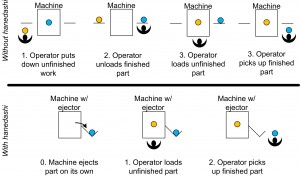Autoejector
An autoejector is a tool used to streamline production. It is also known by the Japanese term, hanedashi.
In a cell where a single operator is running several machines, he will often work with multiple parts. That’s not to say it is a random number. There should be a defined number of pieces of standard work in process. Each automated machine will have an item in it, and the operator will also have an additional piece to either transport or work on. There will also be an additional item for the extra operators and sometimes a piece to manage the transition between operators. (See our entry on Standard Work-in-Process to learn more.)

Without an autoejector, the operator would have to put the part he is holding down, remove the original part from the machine and put it down, pick up the original part, and then load the item.
With an autoejector, the operator could simply walk up to an empty machine, load the part, and then pick up the previously ejected part and continue working. The flow is not interrupted by picking up and putting down parts.
Generally, it is much easier to automate the ejection of a part than the proper loading of a part. Loading takes a lot of finesse that can be hard to dial in on a machine. As a result, automated ejection is far more common than automated loading.
A series of these machines is known as a chaku-chaku line, or load-load line.
See also: Hanedashi


0 Comments